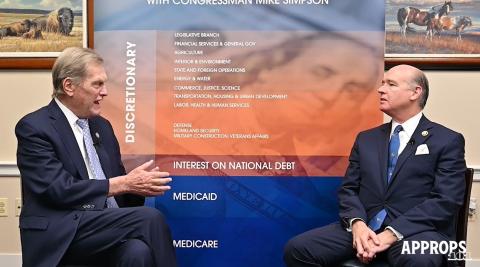LHHS: Fueling Health, Education, and the American Workforce
The Appropriations 101 series continues with Interior and Environment Subcommittee Chairman Mike Simpson sitting down with Robert Aderholt (R-AL), who leads the Labor, Health and Human Services, and Education (LHHS) Subcommittee.
The two discuss the expansive scope of the LHHS bill, and how Chairman Aderholt prioritizes funding at the state and local level. As the second largest Appropriations bill, the Cardinals also examine the importance of tackling the federal deficit by addressing mandatory programs.

Watch Subcommittee Chairman Simpson and Subcommittee Chairman Aderholt’s conversation here.
Simpson: “Robert, tell us a little bit about the Labor, Health and Human Services and Education budget. We always call the Subcommittee Labor-H, but education is a big part of it too.”
Aderholt: “Education is a big part, but Labor, Health and Human Services are, of course, the main part of the funding. Overall, the spending for this entire bill is about $185 billion. As you rightly said earlier, when you take all three departments and all the agencies that are under our Committee, you've got the second largest bill. Defense is the only one that’s larger. So, $185 billion to decide discretionary money is a lot of money to decide. Obviously, there's a lot of money that goes into the Department of Health and Human Services, which is probably $100-$110 billion that goes to that department alone. Then you have the Department of Education, which is about $70-$75 billion, depending on the year. Then you have about $10 billion, approximately, that goes to the Department of Labor. Those are the three components, the three large components.”
…
Simpson: “Everybody in Congress has a different priority of what is important to them.”
Aderholt: “Well, that's the hard part, and that's what I also tell my constituents, is that you've got 435 Members of Congress, on the House side, that think they know best how to spend that money. You've got 100 Members of the Senate who think they know best how to spend the money. And then, of course, you have to have the President sign off and his Administration. So that's what makes appropriations bills tough. Like you, I'm honored to serve as Chair of one of the subcommittees, and it gives us a great opportunity to try to put money where it needs to be - hopefully at the local level - and make sure we're not spending more than we need to.”
Simpson: “As we try to reduce spending at the federal level in these appropriation bills, and we do work hard to try to do that, and to look at how we're spending it, if it's the most efficient way, get the biggest bang for the buck on how we're doing it, or whether we need to change the way things operate. What I've been trying to explain through all of these different Appropriations 101 videos is that even though [the Labor-H bill is] 11% of discretionary spending, you're only about 2% of the overall spending of the federal government. So, when people think that this is what's driving the debt, it's really not. It's only 2% of the overall spending [and 11%] of the 28% that the Committee funds.”
Aderholt: “That is what is driving [the debt]. It’s the entitlement programs in the country, and what we have to ultimately get a hold in this country. Appropriations is just a small part. If we didn't spend a dime on appropriations for the military or for anything from the federal level, we would not balance the budget. We wouldn’t even come close.”
###
